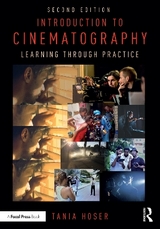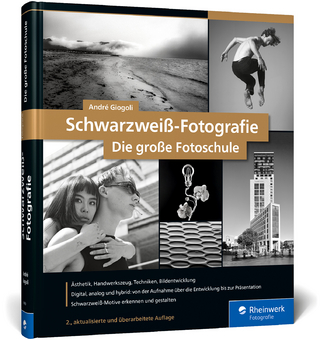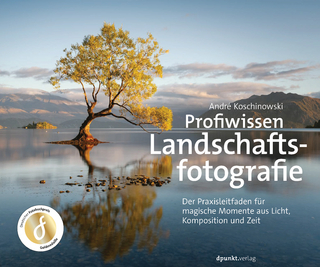
Introduction to Cinematography
Routledge (Verlag)
978-1-138-23514-4 (ISBN)
Introduction to Cinematography offers a practical, stage-by-stage guide to the creative and technical foundations of cinematography. Building from a skills-based approach focused on professional practice, cinematographer and author Tania Hoser provides a step-by-step introduction for both cinematographers and camera assistants to the techniques, processes, and procedures of working with cameras, lenses, and light. She provides hands-on insight into negotiating with production constraints and understanding the essentials of the image workflow from shot to distribution, on projects of any scope and budget.
Richly illustrated, the book incorporates exercises and sample scripts throughout, exploring light, color, movement, ‘blocking’, and pacing scenes. The principles and techniques of shaping and controlling light are applied to working with natural light, film lamps, and, as with all areas of cinematography, to low budget alternatives. This makes Introduction to Cinematography the perfect newcomer’s guide to learning the skills of cinematography that enables seamless progression from exercises through to full feature shoots. Assessment rubrics provide a framework to measure progress as the reader’s ability to visually interpret scripts and enhance the director’s vision develops.
The book also teaches readers:
To understand and develop the combination of skills and creativity involved in cinematography;
Photographic principles and how they are applied to control focus exposure, motion blur, and image sharpness;
To identify the roles and skills of each member of the camera department, and how and when each are required during a shoot;
The order and process of lighting on all scales of productions and the use and application of the four main types of lamps;
How to use waveforms, false color, and zebras for monitoring light levels, and meters for guiding exposure choices;
The principles of the color wheel, color palettes, and the psychological effects of color choices;
How to shoot for different types of fiction and nonfiction/documentary films and how to apply these skills to other genres of TV and film production;
Strategies for both starting and progressing your career within cinematography and the camera department.
**Winner of 'Best new Textbook in Humanities and Media Arts' in the Taylor and Francis Editorial Awards 2018**
Tania Hoser started her career as a union apprentice and later worked her way up through the camera grades on feature films and commercials. Tania completed her training at the Royal College of Art, where she won the Kodak and Metz cinematography prizes and shot six award-winning films. During this time, she also had several television commissions as a writer/director. She has taught film, photography, and cinematography at universities in several countries, including the University of the West Indies, Barbados, and Abu Dhabi Women’s College, United Arab Emirates.
Acknowledgements
Preface
SECTION A: Part 1 - Understanding and Learning Cinematography
Chapter 1: Cinematography: The Bigger Picture (Part 1)
SECTION B - Essential Working Knowledge for Cinematographers and Camera Assistants
Chapter 2a: Working on Set - Professional Practice
Chapter 2b: Camera Assistant Skills
Chapter 3: Fundamental Photographic Knowledge for Cinematography
Chapter 4a: Assembling the Camera and Preparing to Shoot
Chapter 4b: Camera Preparation and Testing
SECTION C - Shots and Storytelling
Chapter 6: Storytelling in Shots - Lenses and Composition
Chapter 7: Storytelling in Scenes - Constructing the Scene and Working with the Director
Chapter 8: Speed and Time
SECTION D - Shooting Creatively and Effectively When Working Alone
Chapter 9: Solo Shooting: Documentary and Television
SECTION E - Camera Operating and Methods of Moving the Camera
Chapter 10: Camera Operating
SECTION F - Light and Lighting
Chapter 11a: Lighting - The Fundamentals of Lighting Light Metering and Exposure
Chapter 11b: Lighting - Natural and Available Light
Chapter 12: Shaping and Controlling Light
Chapter 13: Lighting Locations and Studio Sets
SECTION G - Color, Image Control and Creating The 'Look' of the Film: Combining and Using All Aspects of Cinematography Creatively
Chapter 14: Color, Image Control and the Look of the Film
SECTION A: Part 2 - Working in the Film and Television Industries
Chapter 15 Starting and Developing a Career in Cinematography
Appendix
Camera Department Hierarchy
Asessment Rubric
Script 1
Script 2
Index
| Erscheinungsdatum | 07.11.2018 |
|---|---|
| Zusatzinfo | 9 Tables, black and white; 450 Illustrations, color |
| Verlagsort | London |
| Sprache | englisch |
| Maße | 210 x 280 mm |
| Gewicht | 1240 g |
| Themenwelt | Kunst / Musik / Theater ► Film / TV |
| Kunst / Musik / Theater ► Fotokunst | |
| Sachbuch/Ratgeber ► Freizeit / Hobby ► Fotografieren / Filmen | |
| ISBN-10 | 1-138-23514-8 / 1138235148 |
| ISBN-13 | 978-1-138-23514-4 / 9781138235144 |
| Zustand | Neuware |
| Informationen gemäß Produktsicherheitsverordnung (GPSR) | |
| Haben Sie eine Frage zum Produkt? |
aus dem Bereich



